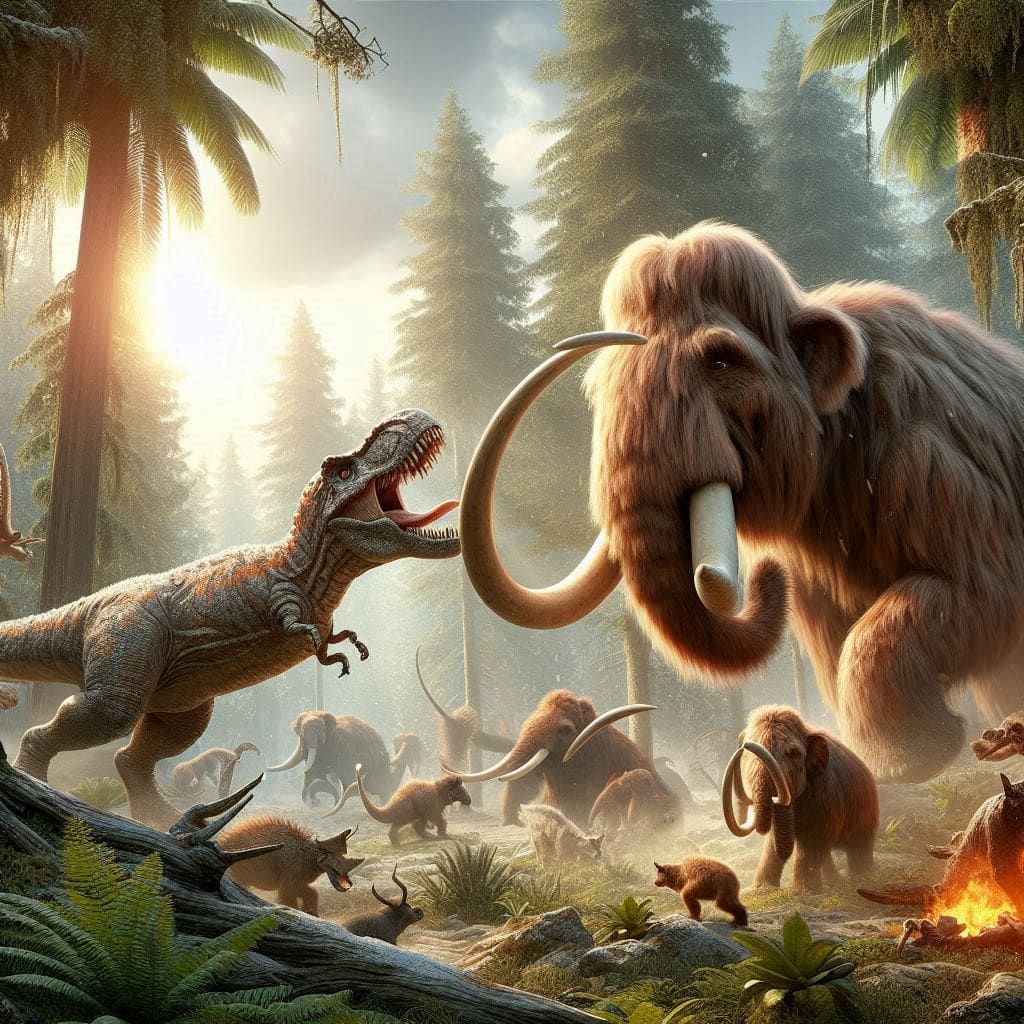
Mammoth Features and Ecology
Introduction
Mammoths, particularly the woolly mammoth (Mammuthus primigenius), are among the most iconic prehistoric animals. These majestic creatures roamed the Earth during the Pleistocene epoch, thriving in the cold, glacial environments of the Northern Hemisphere. This blog delves into the physical characteristics, ecological roles, and the environments that supported mammoth populations.
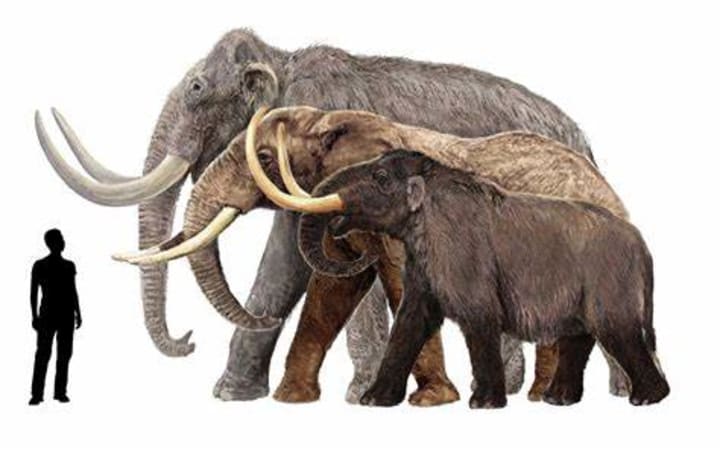
Physical Characteristics
Size and Build
Height and Weight: Woolly mammoths stood about 10 to 12 feet (3 to 3.7 meters) tall at the shoulder and weighed between 6 to 8 tons, comparable in size to modern African elephants.
Body Structure: Mammoths had a hump on their shoulders formed by deposits of fat, which likely provided energy reserves during harsh winters.
Fur and Adaptations
Thick Fur: Woolly mammoths were covered in a dense coat of fur, with an outer layer of long guard hairs up to 3 feet (1 meter) long and a shorter, dense undercoat. This adaptation was crucial for insulation against the cold.
Fat Layer: Beneath their skin, mammoths had a thick layer of subcutaneous fat, which further insulated them from the cold and stored energy.
Curved Tusks: Mammoth tusks could reach lengths of up to 15 feet (4.5 meters). These tusks were used for digging through snow to find vegetation, for fighting, and possibly for social displays.
Teeth
Grinding Molars: Mammoths had large, flat molars designed for grinding tough, fibrous vegetation. These teeth were replaced several times throughout their lives, with new sets growing as old ones wore down.
Habitat and Distribution
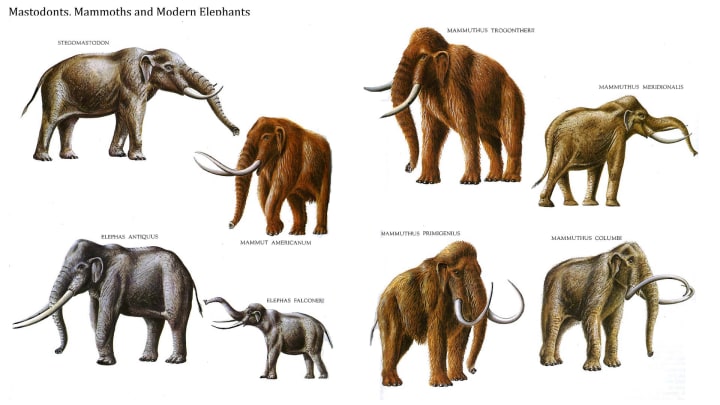
Geographic Range
Northern Hemisphere: Mammoths primarily lived in the northern regions of North America, Europe, and Asia. Their range extended across the vast, open landscapes of the mammoth steppe, a unique biome characterized by cold, dry climates.
Mammoth Steppe
Climate: The mammoth steppe was an arid, grassland ecosystem that existed during the Pleistocene epoch. It spanned much of the Northern Hemisphere and supported a diverse array of large herbivores.
Vegetation: This ecosystem was dominated by grasses, herbs, and shrubs, providing a rich food source for mammoths. Unlike the modern tundra, the mammoth steppe had less snow cover, allowing mammals to access vegetation even during winter.
Ecological Role
Herbivory
Diet: Mammoths were herbivores, feeding on a variety of plant materials, including grasses, sedges, shrubs, and tree bark. Their large molars were well-suited for grinding down tough vegetation.
Foraging Behavior: Mammoths used their tusks and trunks to dig through snow and break apart ice to reach buried plant matter. This foraging behavior had a significant impact on their environment, influencing vegetation patterns and soil composition.
Ecosystem Engineers
Impact on Vegetation: By uprooting trees and shrubs, mammoths helped maintain the open grasslands of the mammoth steppe. Their grazing and trampling created a dynamic landscape that supported a diverse array of plant and animal species.
Dung: Mammoth dung contributed to nutrient cycling in their habitats, providing essential nutrients for plant growth and supporting other organisms, such as dung beetles.
Interactions with Other Species
Predators: Adult mammoths had few natural predators due to their size, but calves and juveniles were vulnerable to large carnivores, such as saber-toothed cats and wolves.
Competition: Mammoths coexisted with other large herbivores, including bison, horses, and rhinoceroses. They competed for the same food resources but also contributed to a balanced ecosystem by maintaining diverse plant communities.
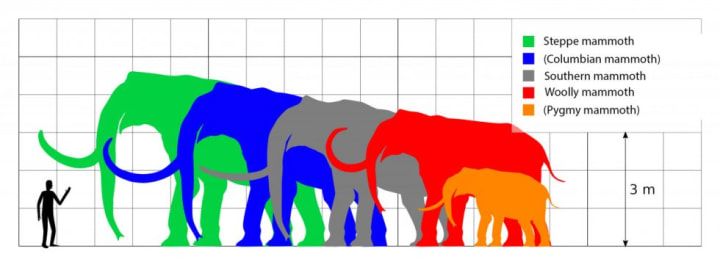
Adaptations to Cold Environments
Fur and Fat
Insulation: The thick fur and subcutaneous fat layers of woolly mammoths were crucial adaptations for surviving in the frigid climates of the mammoth steppe. These features provided excellent insulation and energy reserves during food shortages.
Heat Regulation
Blood Circulation: Mammoths had specialized blood vessels in their extremities that helped regulate body temperature. These vessels reduced heat loss in the cold and prevented frostbite.
Behavioral Adaptations
Seasonal Migration: Mammoths likely migrated seasonally to follow food sources, moving to more temperate regions during the harshest winter months and returning to the steppe in summer.
Social Structure: Mammoths lived in herds, similar to modern elephants. These social groups provided protection against predators, helped care for young, and facilitated finding food.

Extinction
Climate Change
Warming Climate: The end of the Pleistocene epoch saw significant climate warming, which led to the retreat of glaciers and the transformation of the mammoth steppe into modern tundra and boreal forests. These changes reduced the availability of the mammoth's preferred grassland habitat.
Human Hunting
Overhunting: Human populations expanded into mammoth territories, and evidence suggests that hunting played a role in their extinction. Mammoth remains at archaeological sites show signs of butchery, indicating they were an important resource for early humans.
Combination of Factors
Synergistic Effects: The extinction of mammoths was likely due to a combination of climate change, human hunting, and other ecological pressures. As their populations declined, mammoths became more vulnerable to these combined threats.
Legacy and Discoveries
Fossil Evidence
Preservation: Mammoth remains have been discovered in various states of preservation, from bones to entire carcasses frozen in permafrost. These discoveries provide invaluable insights into their biology, ecology, and interactions with humans.
DNA Analysis
Genetic Studies: Advances in DNA analysis have allowed scientists to extract and study mammoth DNA from well-preserved specimens. These studies have revealed details about their evolutionary history, genetic diversity, and relationships with modern elephants.
Cloning and De-extinction
Scientific Efforts: There is ongoing scientific interest in the possibility of bringing mammoths back to life through cloning and genetic engineering. While these efforts are still in the experimental stage, they raise important ethical and ecological questions about de-extinction.
Tyrannosaurus rex: Features and Ecology
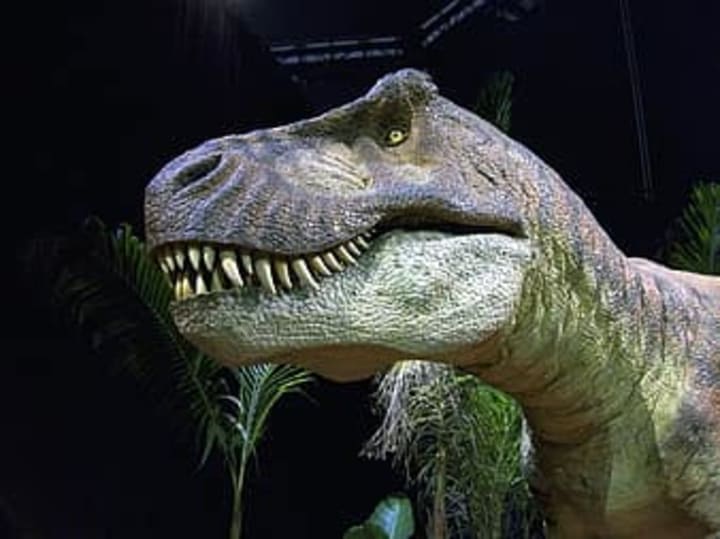
Introduction
Tyrannosaurus rex, often abbreviated as T. rex, is one of the most iconic and well-studied dinosaurs. Known for its massive size, powerful build, and predatory nature, T. rex lived during the late Cretaceous period, about 68 to 66 million years ago. This blog explores the physical characteristics, ecological role, and behaviors of T. rex, providing a comprehensive look at this fascinating creature.
Physical Characteristics
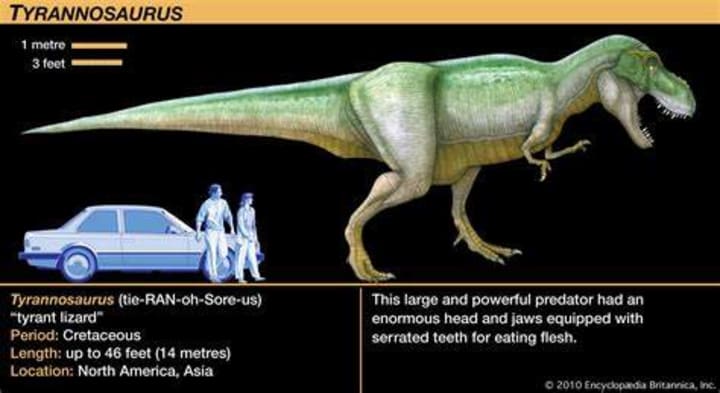
Size and Build
Height and Length: T. rex stood about 12 feet (3.6 meters) tall at the hips and measured up to 40 feet (12 meters) in length from head to tail.
Weight: It could weigh between 9 to 14 tons, making it one of the largest terrestrial carnivores.
Skull and Teeth
Massive Skull: The skull of T. rex was about 5 feet (1.5 meters) long, with large fenestrae (openings) that reduced weight while maintaining strength.
Powerful Jaws: T. rex had incredibly powerful jaws, capable of exerting a bite force of up to 12,800 pounds (5,800 kg), the strongest of any known terrestrial animal.
Teeth: Its teeth were thick, serrated, and conical, each up to 12 inches (30 cm) long. These teeth were designed to puncture and tear through flesh and bone.
Limbs and Locomotion
Hind Limbs: T. rex had robust hind limbs that supported its massive weight and allowed it to move efficiently. It is estimated to have been capable of running at speeds of up to 20 miles per hour (32 kilometers per hour).
Forelimbs: Despite their small size, the forelimbs of T. rex were incredibly strong, with two clawed fingers that could grasp and hold prey.
Tail
Balance and Stability: The long, heavy tail of T. rex acted as a counterbalance to its massive head, aiding in stability and maneuverability.
Sensory Capabilities
Vision
Binocular Vision: T. rex had forward-facing eyes, providing it with binocular vision and depth perception, essential for a predator.
Large Eyes: Its large eyes and keen eyesight likely allowed it to spot prey from a distance.
Olfaction
Sense of Smell: The olfactory bulbs of T. rex were large, indicating a highly developed sense of smell. This would have been useful for tracking prey and scavenging.
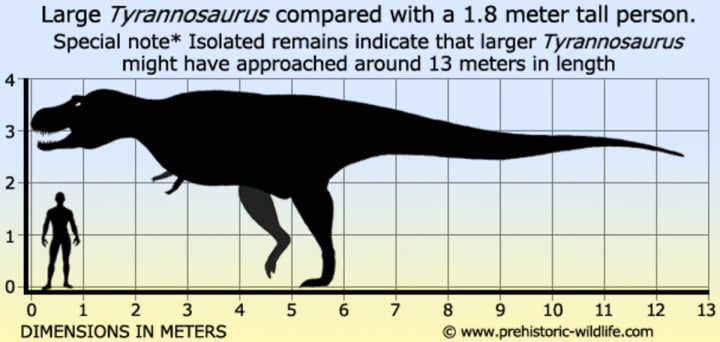
Ecology and Behavior
Habitat
Late Cretaceous Environment: T. rex lived in what is now North America, in a variety of environments including coastal plains, river valleys, and forests. The climate during this period was warmer and more humid than today.
Diet and Feeding
Carnivorous Diet: T. rex was a hypercarnivore, primarily preying on large herbivorous dinosaurs such as Triceratops and Edmontosaurus.
Scavenging Behavior: There is evidence to suggest that T. rex also scavenged, using its keen sense of smell to locate carcasses.
Hunting Strategies
Ambush Predator: T. rex likely employed ambush tactics, using its powerful legs to make short, rapid bursts of speed to catch prey.
Social Behavior: Some paleontologists believe that T. rex may have hunted in packs, although this is still a topic of debate.
Reproduction
Nesting: T. rex is believed to have laid eggs, like other theropods, and may have provided parental care to its young.

Fossil Evidence
Key Discoveries
Sue: One of the most complete and best-preserved T. rex skeletons, discovered in South Dakota in 1990. Sue is on display at the Field Museum in Chicago.
Stan: Another well-preserved skeleton found in South Dakota, providing valuable insights into the anatomy and biomechanics of T. rex.
Bone Structure and Growth
Growth Rates: Studies of T. rex bones indicate rapid growth during adolescence, with individuals reaching full size by their early twenties.
Pathologies: Fossil evidence shows that T. rex individuals often suffered from injuries and diseases, including infections, fractures, and arthritis.
Evolutionary Relationships
Theropod Lineage
Tyrannosaurids: T. rex belonged to the family Tyrannosauridae, which included other large carnivorous dinosaurs such as Albertosaurus and Gorgosaurus.
Evolutionary Traits: The evolution of T. rex involved several adaptations for its predatory lifestyle, including powerful jaws, robust limbs, and keen senses.
Feathered Ancestors
Feather Evidence: While direct evidence of feathers in T. rex is lacking, its smaller relatives, such as Dilong and Yutyrannus, had feathers, suggesting that T. rex may have had some feather covering, especially during its juvenile stages.
Extinction and Legacy
Cretaceous-Paleogene Extinction Event
Mass Extinction: T. rex, along with all non-avian dinosaurs, went extinct approximately 66 million years ago due to the Cretaceous-Paleogene extinction event, likely caused by a combination of an asteroid impact and volcanic activity.
Survival of Relatives: Birds, the descendants of small theropod dinosaurs, are considered the closest living relatives of T. rex.
Cultural Impact
Popular Culture: T. rex has become a symbol of prehistoric life, featured prominently in movies, books, and documentaries, most notably in the "Jurassic Park" franchise.
Scientific Research: T. rex continues to be a focus of scientific research, with new discoveries and technologies providing deeper insights into its biology and behavior.
The hypothetical scenario of a fight between a mammoth and a Tyrannosaurus rex is a fascinating but impossible match-up, given that these two species lived millions of years apart. Mammoths, such as the woolly mammoth (Mammuthus primigenius), existed during the Pleistocene epoch and went extinct around 4,000 years ago. In contrast, Tyrannosaurus rex lived during the late Cretaceous period, about 68 to 66 million years ago. However, imagining such a confrontation provides an interesting exercise in comparing the physical attributes, behaviors, and potential combat strategies of these prehistoric giants.
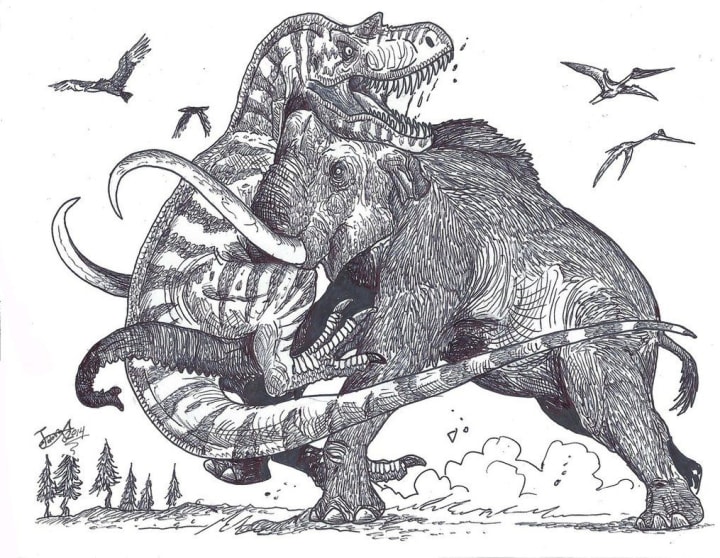
Physical Attributes
Tyrannosaurus rex:
Size and Build: T. rex was one of the largest carnivorous dinosaurs, standing about 12 feet (3.6 meters) tall at the hips and measuring up to 40 feet (12 meters) in length. It could weigh between 9 to 14 tons.
Strength and Speed: T. rex had powerful hind limbs and could run at speeds estimated between 12 to 20 miles per hour (19 to 32 kilometers per hour). Its strong tail helped balance its massive head.
Weapons: T. rex had a massive skull with jaws equipped with around 60 thick, serrated teeth, each up to 12 inches (30 cm) long. Its bite force is estimated to be the strongest of any terrestrial animal, capable of exerting pressures of up to 12,800 pounds (5,800 kg).
Mammoth:
Size and Build: Woolly mammoths were similar in size to modern African elephants, standing about 10 to 12 feet (3 to 3.7 meters) tall at the shoulder and weighing between 6 to 8 tons.
Strength and Speed: Mammoths were not built for speed but were immensely strong, capable of moving through and manipulating their environment using their powerful trunks and tusks.
Defenses: Mammoths had long, curved tusks that could reach lengths of up to 15 feet (4.5 meters). These tusks were used for defense against predators, foraging for food, and possibly in social interactions.
Combat Scenario
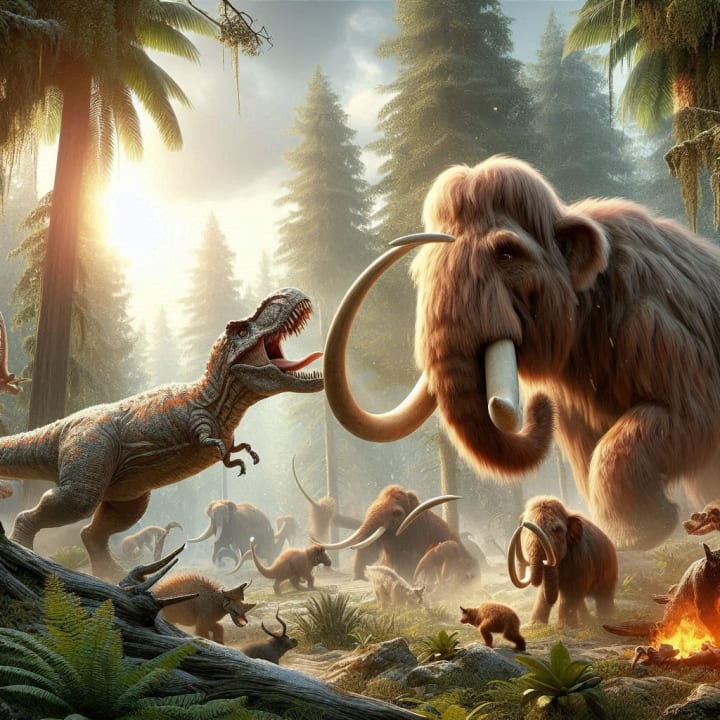
Advantages of T. rex:
Superior Weaponry: The T. rex's powerful jaws and teeth would be formidable weapons against a mammoth. A well-placed bite could cause significant damage.
Speed and Agility: Although not the fastest, T. rex would likely be more agile than a mammoth, allowing it to maneuver around the larger animal.
Predatory Instincts: As a top predator, T. rex was accustomed to hunting and killing large prey, giving it a tactical advantage in a fight.
Advantages of Mammoth:
Sheer Size and Strength: Mammoths were large, powerful animals with the physical strength to potentially fend off a predator, especially using their tusks.
Defensive Strategies: Mammoths could use their tusks to deliver powerful thrusts and swings, which could deter or injure a T. rex. Their size and bulk also made them difficult to take down.
Social Behavior: If the mammoth were part of a herd, other members could come to its aid, creating a formidable defense against a solitary predator like T. rex.
Outcome
In a one-on-one battle, the outcome would heavily depend on the circumstances. If the T. rex could deliver a fatal bite quickly, it might overpower the mammoth. However, if the mammoth could use its tusks effectively and withstand the initial assault, it might be able to injure or deter the T. rex. Additionally, environmental factors and the physical condition of each animal would play crucial roles.
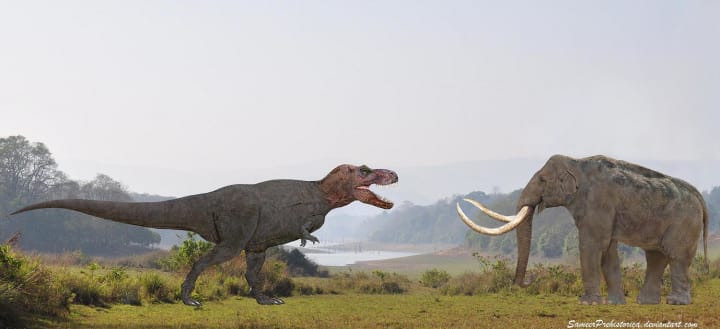
Conclusion
While a direct confrontation between a mammoth and a T. rex is purely speculative and impossible in reality, analyzing their physical characteristics and behaviors offers an intriguing glimpse into the capabilities of these prehistoric giants. The T. rex's predatory prowess and the mammoth's defensive strength highlight the incredible diversity and adaptability of life forms that have existed on Earth.
About the Creator
Enjoyed the story? Support the Creator.
Subscribe for free to receive all their stories in your feed. You could also pledge your support or give them a one-off tip, letting them know you appreciate their work.


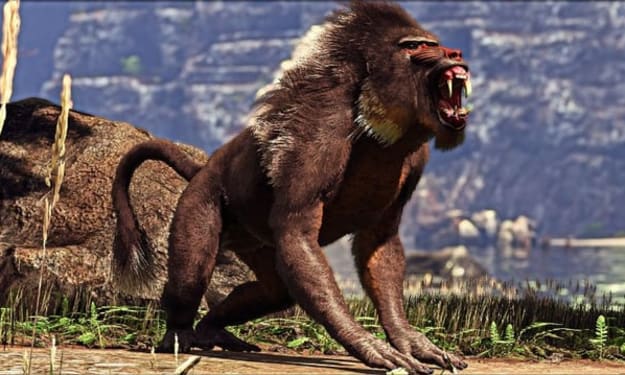



Comments (1)
Nicely done it.